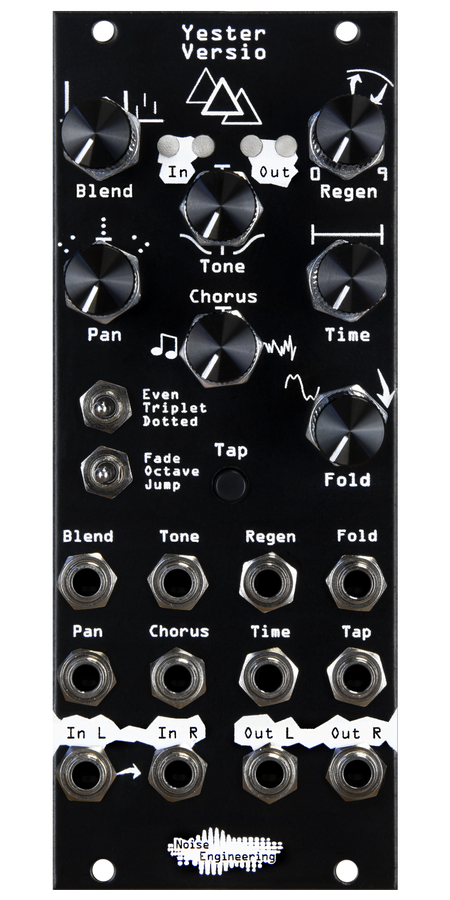Introducing Yester Versio
Spoiler alert: there’s DOOM.
The Versio platform has grown quite a bit since launch: we’re now on firmware number nine with no plans to stop. Yester was a fun challenge for us: we wanted to create something that was straightforward, dead simple to control, and still had some fun tricks up its sleeves. Do modules have sleeves? We’re not sure, but we do know that Yester is a seriously fun delay. Read on to learn more about its history and features!

Delays: Imitor had more, Yester has less(ter?)
The second firmware we released for the Versio was Imitor. Imitor is a twelve-tap delay that was designed to take even the simplest input and create something massive with it. Imitor is a wonderful effect and we’ve heard some absolutely beautiful patches created with it, but a number of users requested a contrasting delay firmware that was easier to use in traditional delay capacities.
Yester started out quite utilitarian: it had no timbral controls outside of a clean filter, no pan controls, no distortion of any kind, and a simple LFO spread out across two knobs. It worked, and it technically did what we set out to do, but we quickly decided it just wasn’t… us.
Our next challenge was to add some character without losing any of the simplicity we’d achieved with the first design. From the start, we aimed to avoid self oscillation: all of the other firmwares that have a Regen control go well beyond 100%, but we wanted to keep Yester tame and easy to jam on. (Much of the later testing came down to avoiding “exploding,” as we affectionately call unintended feedback oscillation.)
Early testing also brought to light just how interesting a pan control could be: Yester is a three-tap delay, and even a small amount of panning on those taps added a new level of interest to the delay effects.
We also wanted to add some more characterful parameters, and so the pitch-shifting chorus was redesigned and the wavefolder was added. (I, Markus, am known for requesting wavefolders be added to pretty much everything. When has there been a time when a wavefolder didn’t make things cooler?) Both of these additions went through many iterations: keeping a delay tame while still adding saturation and wavefolding and doom requires some finesse. Chorus also presented an interesting challenge: we wanted to create a parameter that could introduce subtle modulation for sounds perhaps reminiscent of tape warble, but also had enough range for more extreme effects like pitch shifting.
Right before we were about to ship the firmware and call Yester done for the day, Kris discovered a particularly nasty bug: our so-called “simple” delay was pushing the Versio processor to its limits and creating strange artifacts on some settings. A few headaches/firmware iterations later we had squashed all the bugs and were ready to release Yester to the world.
If you want to hear even more about Yester’s development, as well as some more nitty-gritty technical bits about the firmware, check back next week for a deep dive into Yester’s technical development.
So, enough chatting: what does Yester sound like?
Yester: It’s perfect for simple delays (and so much more)
It’s quite easy to dial things back if you want to create some laid-back repeats. With Fold turned down, and Chorus and Tone centered, you have a mild echo that’s clean and mellow. You can change the number of repeats with the Regen control, adjust the delay timing with Time (or patch in an external clock to sync to your system), and use the Even/Triplet/Dotted switch to create some fun rhythms.
Or, you can make some echoes that are completely out there: turning Chorus to the right adds modulation to the delay lines, creating a… well, chorus effect – traditional choruses are just modulated delays! Turning it to the left transposes the echoes by different intervals, up to an octave when turned fully counterclockwise.
And then there’s Fold, which distorts the delays themselves. Fold starts with some basic saturation, then introduces wavefolding, then DOOM – chaotic suboctaves below the pitch of the delay.
You can hear some fabulous examples of Yester’s timbral range in the manual video below, and you can also explore some fun patch suggestions in the Yester Versio patchbook.
Buy it or try it
Yester Versio is available now from our webshop and your favorite retailers. And as with all Versio firmwares, Yester is also available to use as an alternate firmware, completely free for all Versio owners, from the Noise Engineering Customer Portal. If you’d like to be able to easily reference the controls of different firmwares, we now have laser-cut Versio overlays for all alternate firmwares, including Yester!





